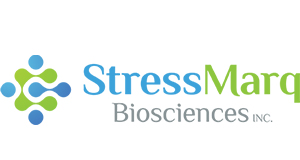CDC37 Protein
Human Recombinant CDC37 Protein
SKU
STRSPR-304B
Packaging Unit
100 µg
Manufacturer
Stressmarq Biosciences
Availability:
loading...
Price is loading...
Target: CDC37
Nature: Recombinant
Swiss-Prot: Q16543
Expression System: E. coli
Amino Acid Sequence: MGHHHHHHMVDYSVWDHIEVSDDEDETHPNIDTASLFRWRHQARVERMEQFQKEKEELDRGCRECKRKVAECQRKLKELEVAEGGKAELERLQAEAQQLRKEERSWEQKLEEMRKKEKSMPWNVDTLSKDGFSKSMVNTKPEKTEEDSEEVREQKHKTFVEKYEKQIKHFGMLRRWDDSQKYLSDNVHLVCEETANYLVIWCIDLEVEEKCALMEQVAHQTIVMQFILELAKSLKVDPRACFRQFFTKIKTADRQYMEGFNDELEAFKERVRGRAKLRIEKAMKEYEEEERKKRLGPGGLDPVEVYESLPEELQKCFDVKDVQMLQDAISKMDPTDAKYHMQRCIDSGLWVPNSKASEAKEGEEAGPGDPLLEAVPKTGDEKDVSV
Purification: Affinity Purified
Purity: >90%
Storage Buffer: 25mM Tris buffer pH7.2, 150mM NaCl, 0.1 mM DTT, 50% glycerol
Protein Size: ~44.5 kDa
Conjugate: His tag
Cellular Localization: Cytoplasm
Scientific Background: HSP90 co-chaperone Cdc37 is a protein that is encoded by the CDC37 gene. It has been found to form complexes with HSP90 and a variety of protein kinases including CDK4, CDK6, SRC, RAF1, MOK and elF-2 alpha kinases. It is thought to play a critical role in directing HSP90 to its target kinases (1, 2). CDC37 is necessary for maintaining prostate tumor cell growth and represents a novel target in the exploration for multi-targeted therapies (3, 4).
References: 1. Dai K., Kobayashi R., Beach D. (1996) J Biol Chem. 271(36): 22030-22034.2. Stepanova L., Leng X., Parker S.B., Harper J.W. (1996) Genes Dev. 10(12): 1491-1502.3. Kimura Y., et al. (1997) Genes Dev. 11(14): 1775-1185.4. Gray P.J., et al. (2008) Nat Rev Cancer. 8(7): 491-495.
Field of Use: Not for use in humans. Not for use in diagnostics or therapeutics. For research use only.
Nature: Recombinant
Swiss-Prot: Q16543
Expression System: E. coli
Amino Acid Sequence: MGHHHHHHMVDYSVWDHIEVSDDEDETHPNIDTASLFRWRHQARVERMEQFQKEKEELDRGCRECKRKVAECQRKLKELEVAEGGKAELERLQAEAQQLRKEERSWEQKLEEMRKKEKSMPWNVDTLSKDGFSKSMVNTKPEKTEEDSEEVREQKHKTFVEKYEKQIKHFGMLRRWDDSQKYLSDNVHLVCEETANYLVIWCIDLEVEEKCALMEQVAHQTIVMQFILELAKSLKVDPRACFRQFFTKIKTADRQYMEGFNDELEAFKERVRGRAKLRIEKAMKEYEEEERKKRLGPGGLDPVEVYESLPEELQKCFDVKDVQMLQDAISKMDPTDAKYHMQRCIDSGLWVPNSKASEAKEGEEAGPGDPLLEAVPKTGDEKDVSV
Purification: Affinity Purified
Purity: >90%
Storage Buffer: 25mM Tris buffer pH7.2, 150mM NaCl, 0.1 mM DTT, 50% glycerol
Protein Size: ~44.5 kDa
Conjugate: His tag
Cellular Localization: Cytoplasm
Scientific Background: HSP90 co-chaperone Cdc37 is a protein that is encoded by the CDC37 gene. It has been found to form complexes with HSP90 and a variety of protein kinases including CDK4, CDK6, SRC, RAF1, MOK and elF-2 alpha kinases. It is thought to play a critical role in directing HSP90 to its target kinases (1, 2). CDC37 is necessary for maintaining prostate tumor cell growth and represents a novel target in the exploration for multi-targeted therapies (3, 4).
References: 1. Dai K., Kobayashi R., Beach D. (1996) J Biol Chem. 271(36): 22030-22034.2. Stepanova L., Leng X., Parker S.B., Harper J.W. (1996) Genes Dev. 10(12): 1491-1502.3. Kimura Y., et al. (1997) Genes Dev. 11(14): 1775-1185.4. Gray P.J., et al. (2008) Nat Rev Cancer. 8(7): 491-495.
Field of Use: Not for use in humans. Not for use in diagnostics or therapeutics. For research use only.

 Deutsch
Deutsch










